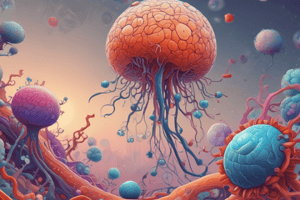Podcast
Questions and Answers
What is the primary function of the cell membrane?
What is the primary function of the cell membrane?
- To house the majority of the cell's genetic material
- To generate energy for the cell through cellular respiration
- To synthesize proteins through translation of mRNA
- To regulate what enters and leaves the cell through selective permeability (correct)
What is the primary function of mitochondria?
What is the primary function of mitochondria?
- To generate energy for the cell through cellular respiration (correct)
- To store genetic material
- To regulate cell growth and division
- To synthesize proteins through translation of mRNA
What is the main site of protein synthesis in a cell?
What is the main site of protein synthesis in a cell?
- Mitochondria
- Cytoplasm
- Ribosomes (correct)
- Nucleus
What is the primary component of cytoplasm?
What is the primary component of cytoplasm?
What is the main function of the nucleus?
What is the main function of the nucleus?
What is unique about the DNA in mitochondria?
What is unique about the DNA in mitochondria?
What is the site of transcription in a cell?
What is the site of transcription in a cell?
What is the function of the phospholipid bilayer in the cell membrane?
What is the function of the phospholipid bilayer in the cell membrane?
What is the jelly-like substance found inside the cell membrane?
What is the jelly-like substance found inside the cell membrane?
Flashcards are hidden until you start studying
Study Notes
Cell Structure and Function
Cell Membrane
- Thin, semi-permeable membrane surrounding the cell
- Composed of phospholipid bilayer with embedded proteins
- Regulates what enters and leaves the cell through selective permeability
- Maintains cellular environment and separates internal components from external environment
Cytoplasm
- Jelly-like substance inside the cell membrane
- Made up of water, salts, sugars, and various organelles
- Site of many metabolic processes, including glycolysis and protein synthesis
- Provides structural support and aids in cell division
Ribosomes
- Small organelles found throughout the cytoplasm
- Site of protein synthesis, where mRNA is translated into amino acid chains
- Can be free-floating or bound to the endoplasmic reticulum
- Responsible for building proteins essential for cellular functions
Mitochondria
- Organelles found in the cytoplasm, often referred to as the "powerhouses"
- Generate energy for the cell through cellular respiration
- Convert glucose into ATP (adenosine triphosphate), the energy currency of the cell
- Have their own DNA and can replicate independently
Nucleus
- Membrane-bound organelle containing most of the cell's genetic material
- Houses the majority of the cell's DNA, organized into chromosomes
- Site of transcription, where DNA is transcribed into RNA
- Regulates cell growth, division, and reproduction through gene expression
Cell Structure and Function
Cell Membrane
- Thin, semi-permeable membrane surrounding the cell, controlling what enters and leaves the cell
- Composed of phospholipid bilayer with embedded proteins, maintaining cellular environment and separating internal components from external environment
Cytoplasm
- Jelly-like substance inside the cell membrane, comprising water, salts, sugars, and various organelles
- Site of many metabolic processes, including glycolysis and protein synthesis, providing structural support and aiding in cell division
Ribosomes
- Small organelles found throughout the cytoplasm, responsible for protein synthesis
- Translate mRNA into amino acid chains, either free-floating or bound to the endoplasmic reticulum
- Build proteins essential for cellular functions
Mitochondria
- Organelles in the cytoplasm, generating energy for the cell through cellular respiration
- Convert glucose into ATP, the energy currency of the cell, with their own DNA and independent replication capabilities
Nucleus
- Membrane-bound organelle containing most of the cell's genetic material, housing the majority of the cell's DNA in chromosomes
- Site of transcription, where DNA is transcribed into RNA, regulating cell growth, division, and reproduction through gene expression
Studying That Suits You
Use AI to generate personalized quizzes and flashcards to suit your learning preferences.




